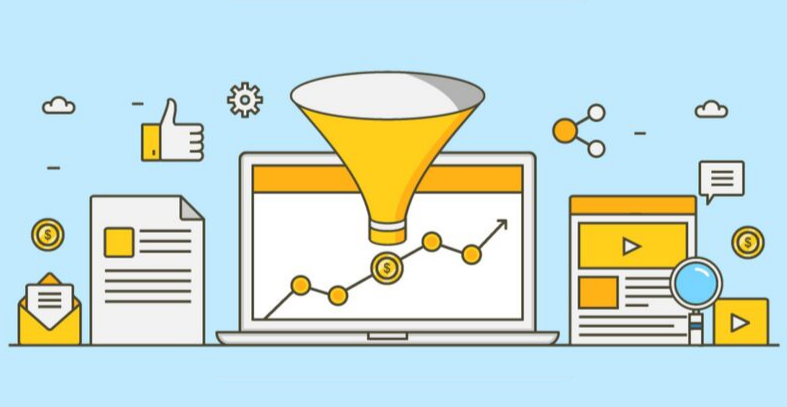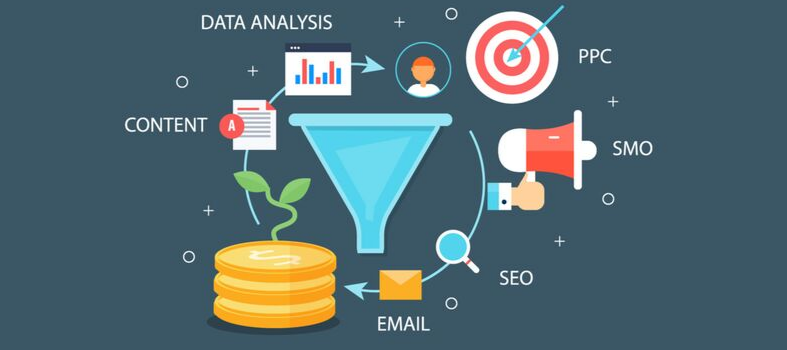Lead scoring is an essential technique that should be initiated at the same time as lead generation. By setting up a lead scoring system, a brand ensures that its leads and prospects are objectively arranged according to a point system. This point system represents the possible value of that lead for the company. The resulting score is used to determine which leads should be treated as a priority by the sales and marketing teams.
Once you start with a qualitative lead generation approach, you automatically gather more and/or better leads by way of logical progression. In many cases, this amount of leads quickly becomes too large to be monitored manually, especially since not every lead is equally valuable. A student who needs a certain document from your company for his or her thesis is far less relevant in the short term than a decision-maker placed within a company that fits right into your target group. By using lead scoring you can help sales to determine priorities, make a clear distinction between general leads, Marketing Qualified Leads and Sales Qualified Leads, and turn the sales process into a shorter, much more relevant process.
Lead scoring: explicit and implicit data
The most accurate models for lead scoring contain both explicit and implicit information. Explicit scores are based on information provided by or about the prospect, such as:
1. Information passed on when the prospect fills in a form on your site
2. Information automatically retrieved from LinkedIn or company databases
3. Information gathered by your company via research, calls or meetings
This type of information goes beyond an email address or name and focuses primarily on company size, type of industry or sector, and position or geographical location. Determining which of these is relevant to your company and which are not is largely done based on your own success ratios: which sectors deliver the most sales success or in which regions do people prefer to work with you, for example. Your buyer personas also determine which people or companies you should make yourself the most appealing to.
Implicit scores are derived from monitoring the behaviour of your leads. These are not directly indicated by the lead but determined based on his or her activities within the digital ecosystem of your company.
1. Which pages has the lead viewed and what role do those pages play in a standard decision process?
2. Which emails have been read and opened, and how many times?
3. For what reasons does the lead come back to the site for information?
4. How does the lead interact with your social channels?
We can also add predictive scores to the mix. These primarily concern elements that can be evoked from AI or machine learning. This option is included as standard in many marketing automation tools which adjust lead scores upon finding ‘incorrect patterns’, such as the use of ‘1234’ or ‘0000’ in telephone numbers. It is possible to surmise which leads do not want to be contacted.
Creating buyer personas
Before you can start lead scoring, you must have a good understanding of the characteristics your ideal customer or buyer persona represents. A buyer persona is a semi-fictional representation of your ideal customer. Each buyer persona profile consists of criteria derived from quantitative research, qualitative observations and existing customer data. The more customers, characteristics and behaviour you are able to analyse, the more complete your knowledge concerning those customers will be. As a result, your lead scoring results will be much more accurate.
Lead point allocation
Once you know what your ideal customer looks like you will need to decide which attributes to assign values to. Criteria for lead scoring can be divided into two main categories: explicit (or demographic) information and implicit (or behavioural) information.
Explicit information refers to those characteristics that a lead possesses. These can relate to their age, location, industry or job title. Implicit will describe their email opens and clicks, subscriptions, webpage visits, form submissions, social media involvement and so on.
Lead point values
Not all scoring criteria are the equivalent of each other. Every company has its own definition of sales readiness. It is therefore impossible to list a one-size-fits-all set of point values. Your company point values must be looked at in detail during lead-scoring analysis.
The purpose of this analysis is to define which characteristics and actions ultimately lead to a closed deal. Customised ‘correct’ values are then linked to these results. Avoid the implementation of ‘vanity metrics’ that might look good on paper but have little true worth, influencing the score with non-associated data. Leads that subscribe to blog updates, for example, are rarely converted into paying customers. Conversely, leads that download a white paper often have a very high conversion rate. In this scenario, blog subscribers might be allocated 2 points and white paper downloaders 30 points.
Demographic data should not be ignored. Perhaps the company’s best clients are businesses with more than 1000 employees and active in the medical sector. On the other hand, demographic data does not apply to every business. Be aware of what is most important to your final goal.
Communicate with sales
Sellers have direct contact with your customers on a daily basis. They have important insight in the factors that qualify a person as a customer and may have a deeper understanding of buying indicators that you have not thought to include in your buyer personas. Check through your CRM data when considering follow ups – a lot of important information can be discovered when looking at the leads that you either do or do not follow up.
Communicate with customers
Your customers can often tell you more about their buyer journey than your sales people or representatives. Talk to some of your best customers and ask them what the first steps were that they took before deciding to make a purchase. You will perhaps discover trends or common factors which in turn can help determine both your lead scoring point allocations and their values.
Analyse your analyses
Analyse the data from all of your previous marketing campaigns. Which have generated the most leads? Which campaigns produced the most buyers? A certain piece of content might be proved to have a high conversion rate. You can then assign a higher score to leads that download this particular piece or similar content types.
Sales Qualified Lead score
After you have assigned a score to each interaction or data point you can add up all the points per lead. This is the final score. It all seems rather simple.
The tricky part is yet to come, however. You must now figure out the scores that represent sales readiness. This step consists of a continuous process of testing and analysis. It is here that lead scoring is implemented for the first time. Only when this test period is complete can you then analyse the sales results and corresponding lead score. If you find a clear cut-off point at which leads no longer become customers or where the nurturing process is excessive, you can apply that minimum threshold and use it to guide the forwarding of SQLs to sales.
Once this threshold figure has been determined, sales and marketing will need to work together (as a Smarketing team) to develop the appropriate nurturing processes for leads with certain scores. For example, if you discover after careful analysis that most leads with a score below 40 never become customers, you only focus on leads with a score over 40. Those who fall below this threshold are placed in a nurture program until they are ready to buy.
Automatic lead scoring
If time, company size, target market numbers, staff or money make it impossible to score manually you may want to take advantage of marketing automation. Automated processes can keep track of the activities of thousands of leads and provide a customised point value system for your integrated data. All you have to do is enter the scoring criteria and the automation tool will give leads a score as they appear. It will also update scores as they change. Determining thresholds still requires intense manual work but automation takes over all but a small fraction of manual follow-up tasks.
What are the benefits of lead scoring?
When you integrate lead scoring you automatically identify and target leads that need nurturing. Leads with a lower score may be looking for added value to increase their interest and involvement. Identification of these scenarios and allowing visitors or potential customers to move into marketing automation flows gives them access to the information they are looking for. This increases their involvement with your company and any potential interest in collaboration.
You are also given the opportunity to test your assumptions about buyer personas and the customer journey when implementing lead scoring methods. How well do you really know your customers? Lead scoring can be implemented as a predictive model that is further refined and improved as time goes by. Incorrect assumptions can be adjusted and correct assumptions can be immediately put into action.
Lead scoring additionally allows you to identify fans and promoters by tracking the most satisfied customers. These customers are often willing to recommend your company when the opportunity arises and this can be encouraged with automated campaigns. Once identified you can give this group just a little more than the masses, inviting them to special panels or being the first to hear of a new product or service.
The entire process of lead scoring also standardises the treatment and evaluation of your leads. In short, it saves a lot of wasted time. By providing marketing and sales with a common evaluation tool for determining the quality of leads, they automatically collaborate. Marketing is now given a numerical value for scoring factors and can further fine-tune those factors based on feedback from sales. This is also essential in the light of targeting your marketing campaigns, since certain factors can be manipulated by targeting specific factors to generate more specific leads. By segmenting the contacts that best suit your business, you can test different approaches that might not work for less interested or lower scoring leads.
When do I start?
Lead scoring may sound like a big project but the steps involved ensure that your entire organisation runs more productively and efficiently. Lead scoring assists your sales and marketing teams in determining which leads are the best and prevents sales from having to deal with unqualified leads. Less time is wasted and more appropriate contact moments can be scheduled.
The best time to start is now. Lead scoring is a proven and reliable method used to produce a more customised customer journey based upon tried and tested buyer persona scores. With automated scoring systems already available, the step need not be too large – however, the returns on your time investment will be.


 1300 353 700
1300 353 700 info@magiknewmedia.com.au
info@magiknewmedia.com.au





















